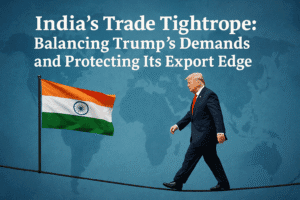India’s Trade Tightrope: Balancing Trump’s Demands and Protecting Its Export Edge
India faces a critical trade dilemma as the August 1 deadline for U.S. negotiations approaches. The Trump administration demands zero-duty market access, risking India’s competitive edge in sectors like pharmaceuticals and engineering goods. While New Delhi may concede on defense deals, LNG imports, and limited procurement access, it has firmly excluded agriculture and dairy.
A 15-20% U.S. tariff hike could erode India’s export advantage over rivals like Vietnam and China—especially if additional BRICS surcharges or trans-shipment penalties apply. Lessons from Japan’s negotiations suggest India could leverage labor-intensive sector demands while deflecting pressure.
With U.S. buyers delaying orders due to uncertainty, a temporary deal may be India’s best bet, followed by extended talks. The outcome hinges on Modi-Trump diplomacy, balancing short-term compromises with long-term trade strategy.

India’s Trade Tightrope: Balancing Trump’s Demands and Protecting Its Export Edge
With the August 1 deadline for U.S. trade negotiations looming, India finds itself in a high-stakes balancing act. The Trump administration’s aggressive push for zero-duty access to Indian markets—mirroring recent deals with Vietnam and Indonesia—has left New Delhi scrambling to safeguard its tariff advantages while avoiding punitive measures.
The Stakes for India
President Trump’s proposed 15-20% baseline tariffs for “the rest of the world” (up from the current 10%) could significantly dent India’s export competitiveness. Key concerns include:
- Comparative Advantage: If India secures a tariff rate closer to 10-15% (similar to Japan and the UK), it retains an edge over Vietnam (20-40%) and China (30-34%). But additional levies—like the 10% BRICS surcharge or trans-shipment penalties—could erase this benefit.
- Critical Exports: Sectors like pharmaceuticals, engineering goods, and electronics rely on Chinese intermediates. A Vietnam-style trans-shipment clause could disrupt supply chains.
- Buyer Hesitation: U.S. importers are delaying orders amid uncertainty, hurting Indian exporters already facing Chinese dumping in European markets.
What the U.S. Wants—And What India Might Give
The U.S. is pushing for:
- Big-Ticket Purchases: Defense equipment, LNG, and nuclear reactors are likely concessions.
- Public Procurement Access: India may offer limited openings, as it did in the UK deal.
- Investment Pledges: Non-binding commitments (similar to Japan’s) could appease Trump’s political agenda.
Notably, India has kept agriculture and dairy off the table—a red line for its domestic economy.
Lessons from Other Negotiations
- Japan’s Playbook: Tokyo diverted attention with agricultural concessions while securing auto sector wins. India could emulate this by emphasizing labor-intensive sector access.
- The China Factor: New Delhi is closely monitoring U.S.-China talks, as any tariff differential could reshape global supply chains.
The Road Ahead
With formal talks set to extend into August, a Modi-Trump conversation may ultimately decide the outcome. Experts suggest India’s best move is a stopgap deal now, followed by phased negotiations into 2026.
Beyond tariffs, the deal could redefine India’s role in global trade—either as a manufacturing alternative to China or a casualty of U.S. protectionism. For now, exporters brace for turbulence, while policymakers weigh short-term pain against long-term strategic gains.
You must be logged in to post a comment.